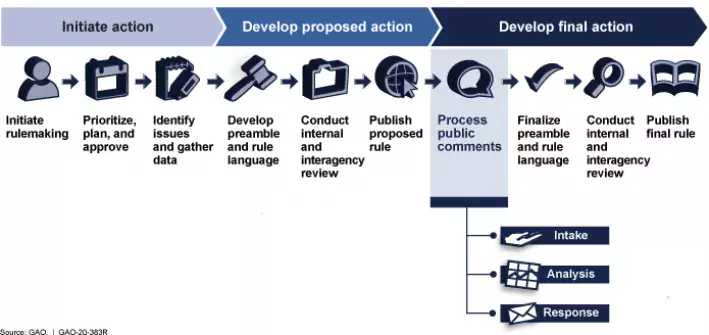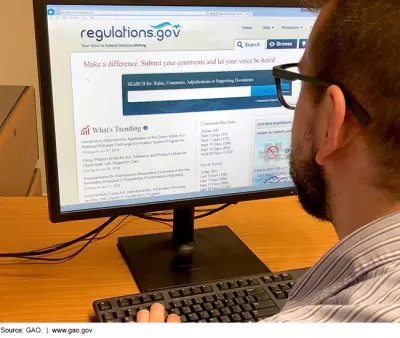Federal Rulemaking
Issue Summary
Congress and presidents have worked to enhance oversight of the federal rulemaking process to promote greater transparency and public participation, and to reduce regulatory burden. For example, recent administrations have directed agencies to identify rules that are obsolete or in need of revision. More recently, President Biden issued an Executive Order directing the Office of Management and Budget (OMB) to recommend ways to improve and modernize the regulatory review process.
The process for creating federal regulations generally has three main phases: initiating rulemaking actions, developing proposed rules, and developing final rules. In practice, however, this process is often complex, requiring regulatory analysis, internal and interagency reviews, and opportunities for public comments.
Image

Transparency of the regulatory process is important—it helps the public better understand the rulemaking process and aids in congressional oversight. Federal agencies need to ensure that they also have effective processes to develop, review, disseminate, and evaluate their regulations, related guidance, and user fees.
There are several ways to improve the transparency and effectiveness of the federal rulemaking process.
For instance:
- Congressional oversight. Oversight of the executive branch is one of Congress's main responsibilities. In recent years, Congress has explored ways to modernize its operations in this area, including regulatory oversight and congressional legal representation for working with the executive branch. There are options that Congress could consider to modify how it fulfills its oversight duties. It can create new regulatory or legal offices, oversight processes, or regulatory requirements—or change existing ones. Each of these options comes with tradeoffs and other considerations. For example, establishing a new office to research proposed rules could increase staff costs and may duplicate existing congressional services.
- Emerging technologies. Regulatory agencies can face challenges in effectively and efficiently regulating new technologies, especially in light of how quickly some of these technologies are brought to market. At times, agencies may need to reassess their regulatory authorities to ensure they have the ability to regulate these products without stifling innovation. They can also take steps to be more transparent about their regulatory efforts.
- Regulatory design. Federal agencies can design their regulations in many ways. For example, some regulatory designs establish an outcome but allow flexibility in how to achieve it, while others are more prescriptive and require certain technologies or actions. Some key considerations for regulatory design and enforcement can help guide agencies in developing rules to achieve intended policy outcomes.
- Midnight rulemaking. Federal agencies may issue more regulations shortly before a president leaves office—i.e., "midnight rulemaking." A review of the Clinton, Bush, Obama, and Trump administrations found that, in the last 120 days of these administrations, agencies published about 2.5 times as many regulations. Congress and individuals outside of the government have expressed concerns that these rules may be rushed through analytical and procedural rulemaking requirements.
- Expedited rulemaking. Federal agencies are usually required to publish a proposed rule in the Federal Register and solicit public comments before finalizing regulations. However, there are exceptions to expedite rulemaking in certain circumstances, such as for an emergency or other “good cause.” Although agencies often request public comments on rules they’ve expedited, they do not always respond to these comments.
- Paperwork burden. Each year, nearly every adult and business provide some form of information to a federal agency—such as benefits applications or tax forms. Agencies estimate the time and resources it takes to provide this information to help manage the paperwork burden placed on the public. The law requires agencies to solicit public input on information collections to validate their estimates. But while agencies often consulted the public via stakeholder and board meetings, they often did not explicitly ask for input on estimates.
Image


